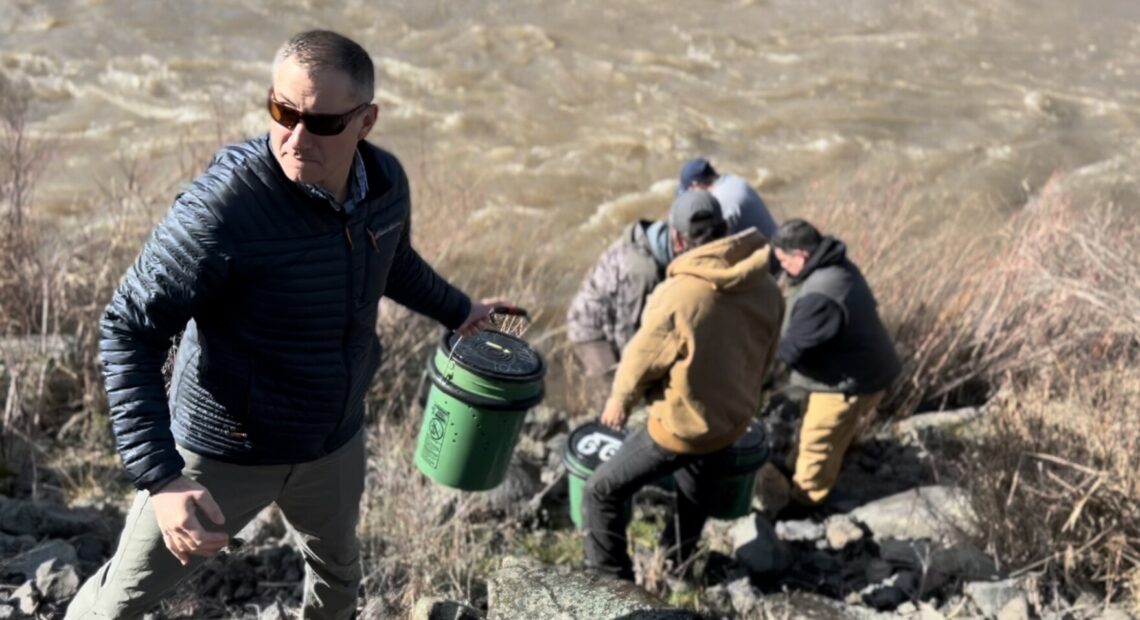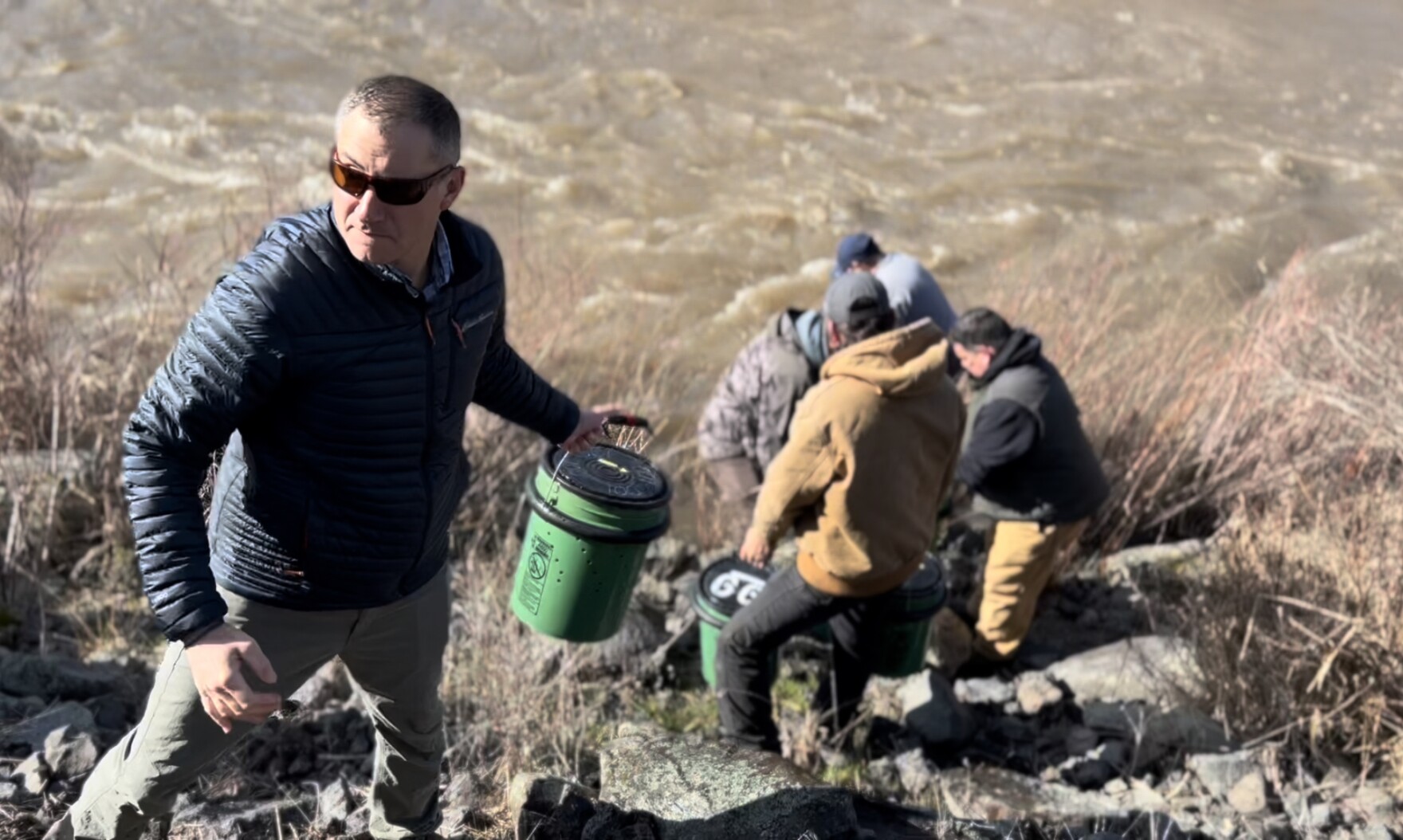A recent salmon release near Spokane will change nearly a century without salmon in nearby waters.
At one of the only remaining undeveloped slices of land in Spokane, the Coeur d’Alene Tribe has started to heal from nearly a century without salmon in nearby waters.
With a gentle splash, tribal members poured around 530 finger-sized summer chinook salmon, a few at a time, into Hangman Creek. This release could be one of the first steps in healing the Coeur d’Alene Tribe, said Hemene James, a council member with the tribe.

“We weren’t farmers. We relied on the salmon to sustain us, our bodies, our minds and our spirits, for tens of thousands of years,” James said. “It’s only been a hundred years or so since we were those people.”
In 1910, the construction of Little Falls Dam blocked fish from reaching habitat on the Spokane River. What James called giant walls continued with the construction of Grand Coulee dam in 1942. The dam cut the Upper Columbia River tribes off from the salmon.
However, the Upper Columbia tribes have started a decades-long plan they hope will one day re-establish salmon above Chief Joseph and Grand Coulee dams.
“We are starting one of the largest opportunities to recover salmon in the Columbia River Basin. We’re talking about thousands of miles of stream and river habitats that can support salmon production,” said Tom Biladeau, a biologist with the Coeur d’Alene Tribe.
These salmon released at Hangman Creek will provide some of the initial information biologists need to figure out how salmon will one day survive in the blocked areas.

Of the fish that were released, researchers implanted 80 fish with acoustic tags that are slightly larger than a grain of rice. The tags will ping at each dam the salmon pass, helping researchers track the downstream journey of the fish.
It took the tribe around 18 months to rear these salmon, which were spawned from adults at Entiat National Fish Hatchery and grown at the reservation in Plummer, Idaho, Biladeau said.
Eventually, the tribe would like to establish a hatchery at this release site in Spokane, part of the tribe’s aboriginal land, said Caj Matheson, natural resource director with the tribe. The tribe acquired the 48-acre Pilcher Property in 2021 so that it wouldn’t be developed into a housing project.
The first five dams the salmon will encounter don’t have any type of fish passage system in place.
That means the salmon released into Hangman Creek will swim over the tops of three dams or through the dams turbines on their journey down the Spokane River.
In the first 24 hours, the salmon should make it past Nine Mile Dam, the first dam on the Spokane River roughly 25 miles from the release site, Biladeau said.
Then, they’ll eventually have to make it through Grand Coulee Dam, where more than 95 percent of the salmon will most likely head downstream through turbines, he said.
Watch: The Coeur d’Alene Tribe releases salmon into Hangman Creek.
Swimming through the turbines won’t lead to a high survival rate, Biladeau said. Turbine blades can strike fish. Fish also can face swift pressure changes, which lead to something like the bends human divers can get when they surface too quickly. In addition, water shear can injure fish when waterways of two different speeds come together.
“I’m sure fish survival will tell us that that’s what’s happening,” Biladeau said of the likely number of deaths salmon will face heading downstream.
Planning for safety in numbers, the tribe scheduled multiple salmon releases downstream of each dam to increase the chances that more of the tagged fish reach the mainstem of the Columbia, Biladeau said.
“Rather than putting all our eggs in one basket and releasing them all here, we want to make sure that there’s fish available to get us data as we progressively move downstream,” Biladeau said.
Researchers will continue to study the data from tagged fish, which they hope will show them how to eventually restore salmon in the Upper Columbia. In Phase 1, researchers identified potential habitats for salmon.
In Phase 2, researchers will begin to test the success of each habitat, Biladeau said. This release marked the first step in Phase 2 of the decades-long process.
At the release, a dozen people lined up along a steep, rocky embankment. They passed buckets holding just a few young salmon to people waiting in the reeds near the rushing water.
At the edge of the creek, Vince Peone, a cultural preservation technician with the tribe, helped people pour salmon into the water.
While Peone may not see salmon in great numbers in this creek, he’s hopeful future generations will benefit from this release. Right now, Peone said he has to travel two to three hours to fish for salmon, relying on salmon tags he has to buy to help stock his freezer for the winter.
He said he hoped that wouldn’t always be the case.
Then, an eagle soared overhead. Peone whistled and looked up at the raptor, saying the Creator gave him a sign.
“I’m still shedding a few tears. The sun’s out, warming me. It’s all part of Creator’s plan, I believe. The eagle flies over us – that’s huge. He’s our messenger. He’s flying over us letting us know that what we’re doing is a great thing,” said Peone, whose grandfather was a Salmon Chief at Spokane Falls.

For the Coeur d’Alene Tribe, this release was greater than the scientific information they will gather, Matheson said.
“For us it’s a heart thing. It’s not a science thing. It’s not an economic thing,” Matheson said. “As we all know, there’s a long history of an imperfect past when it comes to Indian tribes in the United States. I think that doing things like this can reverse that,” Matheson said.
And, James said, it’s not just for the tribe. Everyone needs to understand work like this is for future generations, he said.
“This is not our domain to do with what we please. We need to play our part. We need to accept our responsibility,” James said.
For now, the tribe continues to heal from rough times and atrocities their ancestors experienced, James said. This is a step in the right direction, he said.
“When we do stuff like this, I know that those old ones are sitting in camp across the river, war hooping, having a big dinner,” James said. “Because they know all that they sacrificed was for something. That we didn’t forget.”


















